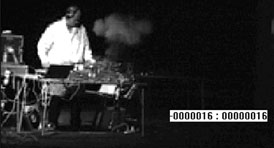Dedication
Introduction
Dan Ariely
Walter Bender
Steve Benton
Bruce Blumberg
V. Michael Bove, Jr.
Cynthia Breazeal
Ike Chuang
Chris Csikszentmihályi
Glorianna Davenport
Judith Donath
Neil Gershenfeld
Hiroshi Ishii
Joe Jacobson
Andy Lippman
Tod Machover
John Maeda
Scott Manalis
Marvin Minsky
William J. Mitchell
Seymour Papert
Joe Paradiso
Sandy Pentland
Rosalind Picard
Mitchel Resnick
Deb Roy
Chris Schmandt
Ted Selker
Barry Vercoe
Chris Csikszentmihályi
I like to make technologies that no one else in the world is making. I see these as both utopian and dystopian. They should work, but also signify. I think I've failed when my work is easily assimilated.

When the word "scientist" was first spoken, in 1833, it was meant as a joke: its coinage first drew laughs and later was attacked as "an American barbarous trisyllable." Up until that point, science was an amateur endeavor, driven by interest in understanding the world. Similarly, machines were as likely to be designed by lay inventors or plant workers as by engineers. People who made technologies were often called "artists," meaning, essentially, makers of things.
Likewise, many of science's foundational devices—microscopes, telescopes, and prisms—were, in fact, used long before in "natural magic," a field that sought to demonstrate the wonders of the world to everyday people. Newton bought his prism at a corner magic shop; voice synthesizers were developed hundreds of years before the computer; complex mechanical characters were entertaining people 300 years before the word "robot" was invented (by a playwright). Put simply, technical imagination was everyone's provenance, and many of the ideas we are still exploring have roots outside of modern science.
In the last 150 years, science and technology have become specialized, while the bulk of fabrication became mass production. This has made our society technological to its very core, but it has also led to a rift between most people and the things they use all day. My own work has been an effort to cross this rift.
Trained as an artist, I was tempted into learning programming, electronics, and machining simply because they are the fabric of today's world. After all, Italian painters of the 15th century were using the most advanced technological system for visualization of their time; why should I settle for less? So, for the last ten years, I've developed speculative technologies and offered critical alternatives to engineering culture. While artists' work may often be seen as "fringe," the flipside is that it is also often visionary. Art education teaches particular sensitivities to culture, history, and society: artists are experts at understanding how what they make can affect the world around them.
The Computing Culture group, which I started in 2001, is aimed at mixing artists, scientists, and engineers who hope to refigure technologies for the full range of human experience. We see our role as providing "exemplar technologies," systems that chart potential directions for our mediated culture. These are working systems, but part of their power is in the stories they tell and the futures they evoke.
These experimental devices may be playful—for instance, our current project "DJ I, Robot" was invented for a subculture: we designed it to challenge Hip Hop's best DJs, much as Deep Blue challenged Kasparov. In the process, the project offered a contribution to one of today's most evocative (and unintentional!) electronic music movements.
Other technologies may be very serious—like the "ISEE" project, enabling citizens to map public surveillance cameras. In some cases, these technologies will have many potential applications—for example, the "Throwing Light" random-access projector we built last year.
In any case, look to Computing Culture to engineer the unexpected, evocative, playful, and exemplary!
Favorite childhood toy: anything anyone in my family made for me—like the pictures my father would draw on my school lunch bags.